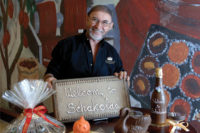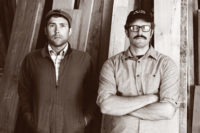One of the first things a newcomer stepping into Dandelion Chocolate’s café and production area on Valencia St. in San Francisco experiences — besides the obvious hipster din and energy — is the large welcoming chalkboard. Aside from the warm greeting, there’s a gentle suggestion to all about the “three things to do while you’re here.”
First, the chalkboard urges everyone to “taste chocolate.” Noting that the company only uses two ingredients in its chocolate bars, cocoa beans and cane sugar, Dandelion Chocolate urges customers to taste samples (Pro Tip: From left to right) to appreciate the “nuances of each bean, harvest and roast.”
The second instruction points out that this location is one of the few places visitors will see chocolate being made right in front of their eyes — literally from bean to bar — and urges everyone to take in the process as well as ask questions.
And finally, because this is both a chocolate production site and a café, it urges customers to “eat a treat. Our pastry chef, Lisa Vega, crafts an ever-changing collection of treats.”
In essence, that blackboard provides a great snapshot of what Dandelion Chocolate is all about, a passionate and transparent commitment to producing handcrafted chocolate. What’s somewhat ironic about the company is that this artisanal bean-to-bar operation has its origins in high-tech.
It was in 2008 that Todd Masonis and Cameron Ring, co-founders of a software company known as Plaxo, sold their operation to Comcast for a reportedly $170 million. The move not only secured their financial future, it also provided them with the luxury of taking some well-deserved time off.
Masonis, who admits to being a lover of all things chocolate, says that neither he nor Ring had any intentions of starting a chocolate company. Both were hanging out with friends from HipChat, helping them with their company, when the two decided to try their hand at making chocolate.
“I’ve toured several chocolate factories and have even been to France to see how they make chocolate,” he admits. “But the original goal was simply to have some fun, to see if we could actually make chocolate.
So after purchasing some cocoa beans off the Internet, along with a toaster oven and a melanger, the two began experimenting with making chocolate in a vacant garage, that space courtesy of the HipChat gang.
“We were actually pleasantly surprised, and thought that this was really easy,” Masonis says. “Actually, I think we just got lucky. So we started sharing the chocolate with our friends and family, who really liked it.”
Recognizing that family and friends would probably not be the most objective critics of their chocolate, especially when it was given out freely, the two decided to try selling the product in San Francisco’s Underground Market, a short-lived but incredible venue “for beginning food entrepreneurs to get their products to the public without the cost and delay of the myriad regulations that have arisen around food production.”
“We thought that if strangers actually opened their wallets to purchase our product, that would be a good sign,” Masonis says.
Well, they did. And it spurred the two Silicon Valley entrepreneurs to seriously consider another life path, that of chocolate makers.
“We realized that this was a unique moment in time, similar to that for coffee and wine, whereby the industry is really changing. Chocolate was having its moment.”
In deciding to “carpe cacao,” the two found a temporary space in the Dogpatch neighborhood of San Francisco. The intent was to locate the retail shop/factory in the Mission District, one of the city’s hot spots for trendy restaurants, shops and galleries. Nonetheless, receiving approval for the necessary permits proved daunting.
“We needed to get out of the garage and opted for a temporary space since it was taking us so long [about a year] to get all the permits for the build-out on our Valencia Street location in the Mission,” he says.
Still, within the course of two years, Dandelion Chocolate had evolved from a concept (2010) to a full-fledged small manufacturing company (2012). During that entire period, demand always outstripped supply.
With opening the Mission District location at the end of 2012, Dandelion was able to expand its production capacity. The new facility also fueled the brand’s popularity.
Masonis points out that the company has been fortunate to receive plenty of good press, as well as garner several awards from the Good Foods group (2012 Gold winner for their 70% Costa Rican bar and 2013 Winner for their 70% Madagascar as well as finalists for their 70% Dominican Republic and Venezuelan bars) and the International Chocolate Award (2013 USA Silver for their Papua New Guinea 70 percent bar).
“We’re pretty proud of our chocolate,” Masonis says. Taking a quick tour of the production process reveals why. As expected, it all starts with the beans. Today, the company sources beans from Madagascar, Ecuador, Belize, the Dominican Republic and Liberia.
As Masonis explains, four main factors affect bean flavor at origin: genetics, terroir, fermentation and drying. At Dandelion, all beans are individually inspected, ensuring that no undersized or imperfect beans are used, which can affect the final flavor.
Masonis admits it’s one of those painstaking processes that reinforce what Dandelion is all about. But given that only sugar is added to make chocolate, bean selection becomes even more critical in producing flavorful and good tasting chocolate bars.
Once inspected, the beans are then roasted five kilos at a time in a modified coffee roaster, temperatures ranging from 180° to 280° F, with roast times taking from 25 to 55 minutes, depending upon the bean.
Again, the appropriate roast times have been gleaned from trials and experimentation, often exceeding 16 to 18 roasts per particular bean. After roasting, the beans undergo cracking and winnowing. Masonis pointed out the self-constructed winnowing tool used, a combination of translucent piping and forced air.
“There’s a limited number of bean-to-bar chocolate makers, so it’s all very friendly,” he says. “It’s a very collaborative community and we talk about tips and tricks. Besides, everything here is on display, it’s all transparent.”
That transparency is evident in the open-air production area in the center of the retail/production space. Six Cocoatown melangers churn chocolate, each batch taking three days to reach the right consistency. Upon determining that the batch is ready — tastes tests are taken periodically — the chocolate is poured into blocks and stored before undergoing tempering.
Typically, the company will produce between five to six different bars, each representing a specific bean origin. Depending upon need, the stored chocolate blocks are removed, melted and then the chocolate fed into the tempering/depositing unit. Once the chocolate is tempered, it’s hand-deposited onto moulds. After cooling, demoulding and hand wrapping follow.
The bars are wrapped in a gold foil and then packed into cases for final wrapping at the company’s new production facility, which is also in the Mission District area. There, a 1950s Otto Hansel wrapper, the only wrapper capable of handling the specially ordered paper that comes from India, completes the job.
And speaking of the new production facility, that’s still a work in progress, Masonis says. The 34, 000-sq.-ft. factory will help alleviate the production crunch that comes from Dandelion’s growing popularity.
Since opening up a café in the their existing Valencia St. location at the beginning of 2013, the company has had a hard time simply meeting demand from the retail shop as well as a kiosk in the Ferry Building in downtown San Francisco.
“There’s plenty of foot traffic on Valencia, but not everyone wants to purchase a piece of chocolate,” he explains. “The café allows people to come in for hot chocolate or coffee and try a pastry or a chocolate.” Naturally, everything served at the café uses Dandelion chocolate.
The company also has a wholesale business, which accounts for 20 percent of its revenues.
“We have distribution of our products in about 200 stores, but we simply can’t accept any more accounts,” Masonis says. “Our waitlist numbers 350-plus.”
Committing to a new production facility, however, wasn’t necessarily a snap decision.
“We thought long and hard about the future at the beginning of this year,” Masonis says. “We could have said that’s as far as we go, but there was so many people wanting our chocolate, we felt we couldn’t disappoint them.”
The $1 million-plus investment, which includes purchase of the building, build-out and equipment, will enable the company to eventually expand its wholesale business. There is, however, no startup target date.
“We want to grow, but without comprising our quality,” Masonis insists. “We’ve seen people spend two years gearing up for production, and then when they turn on the switch, the product isn’t quite right. This is not a monolithic rewrite, but it’s important to have continuous integration. Consequently, we’re testing one machine at a time to ensure we get at least the same or better flavor. This way, we can integrate it into the process.”
Then there’s the whole matter of getting permits and adhering to city codes. Even adding an external stairway can prove to be time-consuming and costly, a process that was quite foreign to the software developers.
“In the software business, you develop an app and then see if people buy it,” he explains. “There was a lot less regulation involved. Dealing with the city’s planning department is more time-consuming.”
But despite the regulatory environment, Masonis and Ring have proven one thing: If you create a good chocolate bar, people will come and buy it. At this point in time, it’s all about “having fun,” producing good chocolate and controlling the growth of Dandelion...in a good way.
Related:
Recchuiti Confections
Raaka Chocolates















